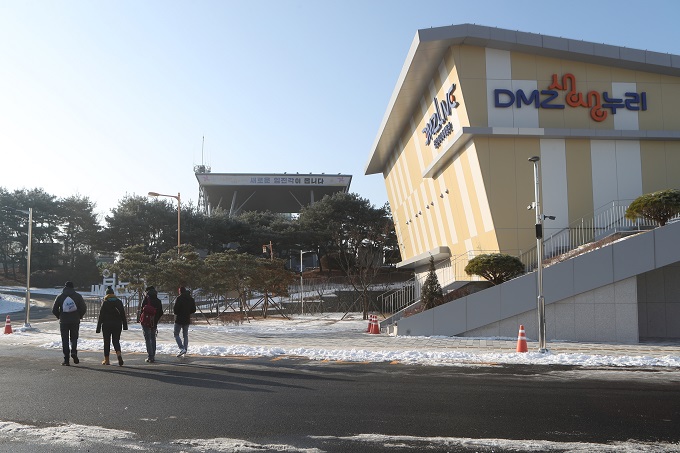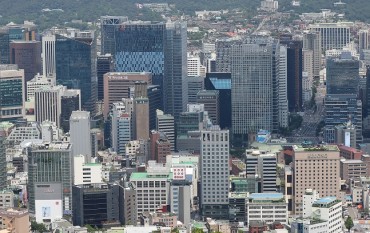
In this file photo dated June 21, 2017, a North Korean drone is displayed at the defense ministry in Seoul after it was discovered in Inje, Gangwon Province, in northeastern South Korea. Suspected North Korean drones crossed the inter-Korean border on Dec. 26, 2022, without South Korea’s permission, prompting the deployment of fighter jets, choppers and other assets to shoot them down, an official at the Joint Chiefs of Staff said. (Yonhap)
SEOUL, Dec. 27 (Korea Bizwire) — North Korean drones’ infiltrations into South Korea’s airspace this week have demonstrated a new layer of complexity in its national security posture that has focused largely on the recalcitrant neighbor’s missile and nuclear threats rather than such small, hard-to-intercept flying objects, analysts said Tuesday.
The South’s defense authorities were caught off guard by five unmanned aerial vehicles (UAVs) that flew across the Military Demarcation Line on Monday, with one of them having even penetrated northern Seoul.
It marked the first time in five years that a sortie of the North’s drone across the heavily fortified inter-Korean border has been detected and publicly known.
The South’s five-hour-long operation to shoot them down failed, and the incident served as a sobering reminder that North Korean drones, feared to be capable of attack missions, potentially including chemical and biological ones, could be instrumental in blindsiding the South.
The South’s Joint Chiefs of Staff (JCS) launched an inspection Tuesday of border units to see if there were any “shortfalls or deficiencies” in its operations against the North Korean UAVs, each about 2 meters long.
In response to public skepticism over the South’s counter-drone competence, its military officials pointed out the limits in identifying small drones as well as difficulties shooting them over populated civilian areas.
“There are considerable restrictions in detecting and identifying drones less than 3 meters (in size),” JCS spokesperson Col. Lee Sung-jun told a regular press briefing, saying the military’s operation has been limited to avoid any damage to civilians.
In an apparent move to assuage public security concerns, President Yoon Suk Yeol vowed during a Cabinet meeting to advance the timing of the establishment of an envisioned military unit tasked with drone-based surveillance and reconnaissance operations.
For Monday’s counter-drone mission, the South deployed mostly propeller aircraft, like Apache attack helicopters and KA-1 light attackers, as supersonic jets fly too fast to keep track of drones known to have traveled around 100 kilometers per hour.
The operation appears to have proceeded in line with the procedures that the military has crafted based on lessons from earlier North Korean drone infiltrations, including those in 2014 and 2017.

Tourists from foreign countries leave Imjingak Pavilion in the South Korean border city of Paju, north of Seoul, on Dec. 27, 2022, as tours to the inter-Korean truce village of Panmunjom were suspended after five North Korean drones intruded across the inter-Korean border, with one of them having flown over northern Seoul, the previous day. (Yonhap)
But its failure to destroy the drones underscored the need for improvement, analysts said.
“Hopefully, the U.S. and South Korean authorities will start to take these threats seriously and prepare appropriate defenses,” Bruce Bennett, a senior defense analyst at the U.S.-based think tank, RAND Corp., told Yonhap News Agency, stressing the drone penetration into Seoul makes a “significant political statement of North Korean military capability.”
Bennett recommended a series of defense steps, such as fielding electronic jamming measures on South Korean fighters that can be used to block signals going from the North to the drones and cause drones to crash.
He also floated the idea of building “hit-to-kill” interceptors carried by South Korean fighters and launching the interceptors to knock a drone out of the sky without having to shoot many bullets at the risk of public safety on the ground.
The North might have carried out drone incursions for various purposes, such as checking drone camera functions or other devices, testing South Korean border defenses as well as collecting intelligence on South Korean forward units, Bennett said.
The North’s UAV program seems to be part of efforts to counter air superiority of the South Korea-U.S. alliance boasting high-end military hardware, such as stealth fighters.
The reclusive country has long sought to advance its low-cost but most effective programs to close the military gap, including nurturing cyber experts long accused of online incursions in South Korea and elsewhere for cryptocurrency theft and other purposes.
“The North’s drone program appears to be part of a struggle to offset the airpower gap with the overwhelming South Korea-U.S. alliance,” Nam Chang-hee, a professor of political science at Inha University, said.
“It seems the North wants to show it has its own asymmetric weapon, perhaps for its own psychological comfort or to inflict a psychological shock on the South.”
The North is known to have been developing drones since the 1990s with the aim of bolstering its overall surveillance capabilities.
It is estimated to have as many as 1,000 drones, including the “Banghyun” series based on an imported Chinese D-4 drone system.
The South’s military also boasts a formidable fleet of hundreds of high-tech UAVs, including the four Global Hawk surveillance aircraft that were brought in here from the U.S. from 2019-20.
(Yonhap)





